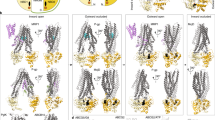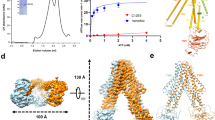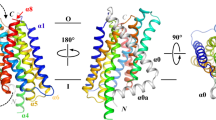Abstract
ABC transporters (also known as traffic ATPases) form a large family of proteins responsible for the translocation of a variety ofcompounds across membranes of both prokaryotes and eukaryotes1. The recently completed Escherichia coli genome sequence revealed that the largest family of paralogous E. coli proteins is composed of ABC transporters2. Many eukaryotic proteins of medical significance belong to this family, such as the cystic fibrosis transmembrane conductance regulator (CFTR), the P-glycoprotein (or multidrug-resistance protein) and the heterodimeric transporter associated with antigen processing (Tap1–Tap2). Here we report the crystal structure at 1.5 Å resolution of HisP, the ATP-binding subunit of the histidine permease, which is an ABC transporter from Salmonella typhimurium. We correlate the details of this structure with the biochemical, genetic and biophysical properties of the wild-type and several mutant HisP proteins. The structure provides a basis for understanding properties of ABC transporters and of defective CFTR proteins.
This is a preview of subscription content, access via your institution
Access options
Subscribe to this journal
Receive 51 print issues and online access
$199.00 per year
only $3.90 per issue
Buy this article
- Purchase on Springer Link
- Instant access to full article PDF
Prices may be subject to local taxes which are calculated during checkout





Similar content being viewed by others
References
Doige, C. A. & Ames, G. F.-L. ATP-dependent transport systems in bacteria and humans: relevance to cystic fibrosis and multidrug resistance. Annu. Rev. Microbiol. 47, 291–319 (1993).
Blattner, F. R.et al. The complete genome sequence of Escherichia coli K-12. Science 277, 1453–1474 (1997).
Nikaido, K., Liu, P.-Q. & Ames, G. F.-L. Purification and characterization of HisP, the ATP-binding subunit of a traffic ATPase (ABC transporter), the histidine permease of Salmonella typhimurium. Solubilization, dimerization, and ATPase activity. J. Biol. Chem. 272, 27745–27752 (1997).
Liu, C. E. & Ames, G. F.-L. Characterization of transport through the periplasmic histidine permease using proteoliposomes reconstituted by dialysis. J. Biol. Chem. 272, 859–866 (1997).
Liu, C. E., Liu, P.-Q. & Ames, G. F.-L. Characterization of the adenosine triphosphatase activity of the periplasmic histidine permease, a traffic ATPase (ABC transporter). J. Biol. Chem. 272, 21883–21891 (1997).
Baichwal, V., Liu, D. & Ames, G. F.-L. The ATP-binding component of a prokaryotic traffic ATPase is exposed to the periplasmic (external) surface. Proc. Natl Acad. Sci. USA 90, 620–624 (1993).
Petronilli, V. & Ames, G. F.-L. Binding protein-independent histidine permease mutants: uncoupling of ATP hydrolysis from transmembrane signaling. J. Biol. Chem. 266, 16293–16296 (1991).
Liu, P.-Q. & Ames, G. F.-L. In vitro disassembly and reassembly of an ABC transporter, the histidine permease. Proc. Natl Acad. Sci. USA 95, 3495–3500 (1998).
Kerppola, R. E., Shyamala, V., Klebba, P. & Ames, G. F.-L. The membrane-bound proteins of periplasmic permeases form a complex: identification of the histidine permease HisQMP complex. J. Biol. Chem. 266, 9857–9865 (1991).
Story, R. M. & Steitz, T. A. Structure of the recA protein-ADP complex. Nature 355, 318–324 (1992).
Abrahams, J. P., Leslie, A. G., Lutter, R. & Walker, J. E. Structure at 2.8 Å resolution of F1-ATPase from bovine heart mitochondria. Nature 370, 621–628 (1994).
Saraste, M., Sibbald, P. R. & Wittinghofer, A. The P-loop — a common motif in ATP- and GTP-binding proteins. Trends Biochem. Sci. 15, 430–434 (1990).
Walker, J. E., Saraste, M., Runswick, M. J. & Gay, N. J. Distantly related sequences in the α and β-subunits of ATP synthase, myosin, kinases and other ATP-requiring enzymes and a common nucleotide binding fold. EMBO J. 1, 945–951 (1982).
Pai, E. F.et al. Structure of the guanine-nucleotide-binding domain of the Ha-ras oncogene product p21 in the triphosphate conformation. Nature 341, 209–214 (1989).
Kim, S.-H., Prive, G. G. & Milburn, M. V. in Handbook of Experimental Pharmacology. GTPases in Biology (eds Dickey, B. F. & Birnbaumer, L.) 177–194 (Springer, Berlin, 1993).
Pai, E. F.et al. Refined crystal structure of the triphosphate conformation of H-ras p21 at 1.35 Å resolution: implications for the mechanism of GTP hydrolysis. EMBO J. 9, 2351–2359 (1990).
Shyamala, V., Baichwal, V., Beall, E. & Ames, G. F.-L. Structure-function analysis of the histidine permease and comparison with cystic fibrosis mutations. J. Biol. Chem. 266, 18714–18719 (1991).
Mimura, C. S., Admon, A., Hurt, K. A. & Ames, G. F.-L. The nucleotide-binding site of HisP, a membrane protein of the histidine permease. Identification of amino acid residues photoaffinity-labeled by 8-azido ATP. J. Biol. Chem. 265, 19535–19542 (1990).
Ames, G. F.-L., Mimura, C., Holbrook, S. & Shyamala, V. Traffic ATPases: a superfamily of transport proteins operating from Escherichia coli to humans. Adv. Enzymol. 65, 1–47 (1992).
Bianchet, M. A., Ko, Y. H., Amzel, L. M. & Pedersen, P. L. Modeling of nucleotide binding domains of ABC transporter proteins based on a F1-ATPase/recA topology: structural model of the nucleotide binding domains of the cystic fibrosis transmembrane conductance regulator (CFTR). J. Bionerg. Biomemb. 29, 503–524 (1997).
Cheng, S. H.et al. Defective intracellular transport and processing of CFTR is the molecular basis of most cystic fibrosis. Cell 63, 827–834 (1990).
Otwinowski, Z. in Data Collection and Processing (eds Saway, L., Isaacs, N. & Bailey, S.) 56–62 (SERC Daresbury Laboratory, Warrington, UK, 1993).
Terwilliger, T. C., Kim, S.-H. & Eisenberg, D. Generalized method of determining heavy-atom positions using the difference Patterson function. Acta Crystallogr. A 43, 1–5 (1987).
Cowtan, K. D. Improvement of macromolecular electron-density maps by the simultaneous application of real and reciprocal space constraints. Acta Crystallogr. D 49, 148–157 (1993).
Jones, T. A., Zou, J.-Y., Cowan, S. W. & Kjeldgaard, M. Improved methods for binding protein models in electron density maps and the location of errors in these models. Acta Crystallogr. A 47, 110–119 (1991).
Brünger, A. T.et al. Crystallography & NMR system: a new software suite for macromolecular structure determination. Acta Crystallogr. D 54, 905–921 (1993).
Adams, P. D., Pannu, N. S., Read, R. J. & Brunger, A. T. Cross-validated maximum likelihood enhance crystallograhic simulated annealing refinement. Proc. Natl Acad. Sci. USA 94, 5018–5023 (1997).
Laskowski, R. A., MacArthur, M. W., Moss, D. S. & Thronton, J. M. Procheck — a program to check the stereochemical quality of protein structures. J. Appl. Crystallogr. 26, 283–291 (1993).
Kraulis, P. J. MOLSCRIPT: a program to produce both detailed and schematic plots of protein structures. J. Appl. Crystallogr. 24, 946–950 (1991).
Merritt, E. A. & Bacon, D. J. Raster3D: photorealistic molecular graphics. Methods Enzymol. 277, 505–524 (1997).
Acknowledgements
We thank J. Jancarik for crystallization of native HisP crystals, and D. S. King for carrying out mass-spectroscopy analysis on the native and Se-Met HisP proteins. The MAD data for this study were collected at the Lawrence Berkeley National Laboratory in the Macromolecular Crystallography Facility at beamline 5.0.2 in the Advanced Light Source. This facility is principally funded by the Office of Biological and Environmental Research of the US Department of Energy Offices with contributions from Lawrence Berkeley National Laboratory, Amgen, Roche Biosciences, the University of California, Berkeley, and Lawrence Livermore National Laboratory. This work has been supported by grants from the Health Effects and Life Sciences Research Division, Office of Biosciences and Environmental Research, Office of Energy Research of Department of Energy (to S.-H.K.) and from the NIH (to G.F.-L.A.).
Author information
Authors and Affiliations
Corresponding author
Rights and permissions
About this article
Cite this article
Hung, LW., Wang, I., Nikaido, K. et al. Crystal structure of the ATP-binding subunit of an ABC transporter. Nature 396, 703–707 (1998). https://doi.org/10.1038/25393
Received:
Accepted:
Issue Date:
DOI: https://doi.org/10.1038/25393
This article is cited by
-
Comparative analysis reveals the Genomic Islands in Pasteurella multocida population genetics: on Symbiosis and adaptability
BMC Genomics (2019)
-
Mechanics and pharmacology of substrate selection and transport by eukaryotic ABC exporters
Nature Structural & Molecular Biology (2019)
-
Targeting Nucleotide Binding Domain of Multidrug Resistance-associated Protein-1 (MRP1) for the Reversal of Multi Drug Resistance in Cancer
Scientific Reports (2018)
-
Persistence of the ABCC6 genes and the emergence of the bony skeleton in vertebrates
Scientific Reports (2018)
-
Bioinformatics comparisons of RNA-binding proteins of pathogenic and non-pathogenic Escherichia coli strains reveal novel virulence factors
BMC Genomics (2017)
Comments
By submitting a comment you agree to abide by our Terms and Community Guidelines. If you find something abusive or that does not comply with our terms or guidelines please flag it as inappropriate.



